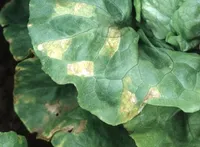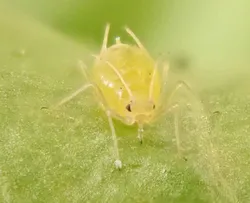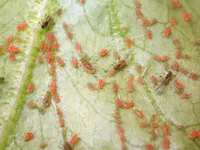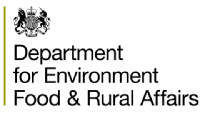Producing an edible lettuce: pesticides or crop genetics?
| The Food and Agriculture Organisation (FAO) of the United Nations have declared 2020 as the International Year of Plant Health (IYPH) and have called for organisations to raise global awareness on how protecting plant health can help end hunger, reduce poverty, protect the environment, and boost economic development. Much of the research in the School of Life Sciences is aimed at improving crop productivity and combating pests and diseases while conserving the environment in order to feed an increasing population. In this series of articles we highlight just some of the work related to IYPH2020. |
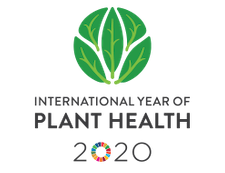
|
Chemical control of pests
When you buy a nice healthy-looking vegetable from the supermarket or farm shop, think about why it is largely free from blemishes and creepy crawlies. It is very likely that it has been treated multiple times with different pesticides (here broadly meaning any chemical used to kill a plant pathogen or pest) to protect it from the many different organisms that want to feed on it. For instance, lettuce is readily infected by the fungus-like oomycete pathogen downy mildew (Bremia lactucae) (pictured right) and may be given weekly fungicide treatments to get a harvestable crop – they don’t tell you that on the label!
Problems with pesticides
For some time agriculture has relied on a range of pesticides in crop production. Although pesticides have to pass a battery of tests to make sure they work as required, meet environmental safety regulations and are safe to us, there are many aspects that make them undesirable. They usually affect a wider range of species other than the those we want to control, they are an extra cost to farmers, and they confer a high selection pressure on the pests which in time inevitably evolve resistance to the chemical and thus diminish its efficacy. Recently, the EU has withdrawn many pesticides on environmental grounds which puts increased pressure on those that remain. In addition, pesticides are hugely expensive to develop and represent a big financial risk to the companies, so there are very few new chemicals coming to market.
The seed we sow
The next time you sow the latest brand new variety of vegetable seed, or even your old favourite, pause for a moment and reflect on what the seed is. The seed contains the genetic blueprint of that variety and confers the genetic potential of the plant. How that potential is realised will depend on the environment the plant experiences as it is raised, i.e. weather, pests and diseases, nutrients and agrochemicals etc. That genetic blueprint is interesting to consider as it encapsulates all the grower/farmer/breeder selections that have taken place since that crop was originally domesticated from the wild hundreds, or even thousands of years ago.
Crop genetics in sustainable farming
One way to reduce the environmental impact of pest control is to breed plants that are innately resistant to the pests – this is therefore a genetic solution. A nice example of this in lettuce was the finding in the mid-1990s of the Nr gene in a wild relative of lettuce that confers resistance to the currant-lettuce aphid (Nasonovia ribisnigri) (pictured left and infested on lettuce right), a major pest of this crop. This gene has since been bred into many commercial varieties. Unfortunately, however, in recent years the aphid has evolved to overcome the Nr gene resistance and, together with the EU ban on the main pesticides used to control it, is becoming a significant pest to UK outdoor lettuce production again.
The role of science in genetic improvement
At the University of Warwick we lead the Defra-funded VeGIN (the Vegetable Genetic Improvement Network) project. In one of our activities in this project we have screened our lettuce diversity collection and identified several strains of lettuce that are resistant to both the original wild-type aphid and the new resistance-breaking biotype of the aphid.
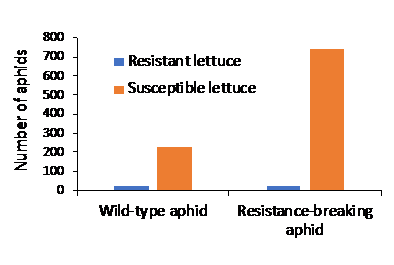
This is great news – so can we just give these to breeders to use? Actually, the assay for aphid resistance we used would be totally impractical to implement in a breeding program. Breeders are interested in the gene(s) for resistance, so if we can find where they are located in the genome we can develop molecular tools, called genetic markers, that tell us whether the resistance genes are present in a plant or not. Breeders can efficiently use these in a process called marker assisted selection to breed the resistance genes into their new varieties. Note, this is routinely used breeding technology and nothing to do with producing genetically modified organisms. As scientists, identifying the genes will also enable us to study the biology of the lettuce-aphid interactions in more detail which could inform improved ways of controlling the pest. Finding the genes is the next phase of our work but this can take a bit of time.
A strategy for durable pest control
In deploying these new sources of lettuce aphid resistance we don’t want the aphid to evolve to overcome them again as it did for the Nr gene. Resistance genes, and also the chemical pesticides, are valuable tools which are difficult, expensive and timely to replace, so it is really important to put effort into looking after what we have got. Unfortunately, this is something that not much attention has been paid to in the past, but now there are increasing drivers to do so. The best way to achieve this is to not rely exclusively on just one control method (e.g. the resistance gene), but to use a combination of methods that work in synergy with each – this is known as integrated pest management (IPM).
To more articles as part of International Year of Plant Health 2020

